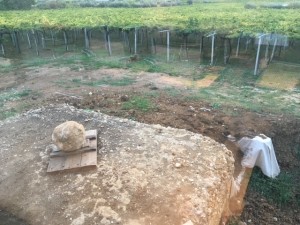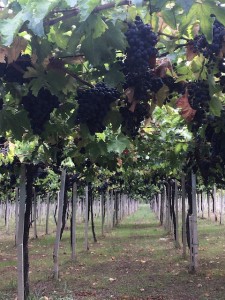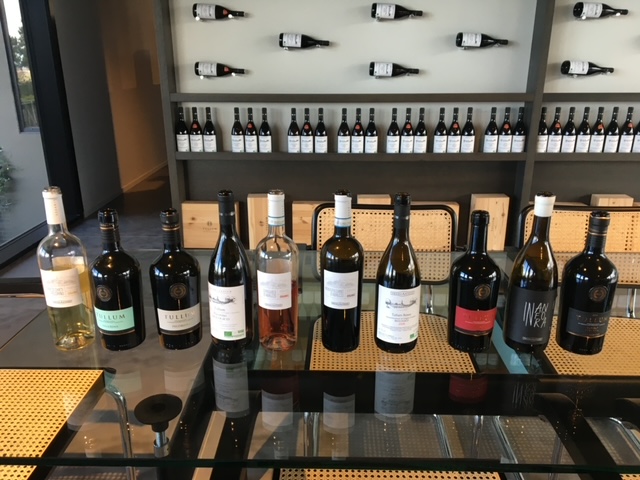
Discovering the cisterns of an ancient villa. PHOTO: TERRY DUARTE.
The study of the soil characteristics, microclimate and rootstocks with defining individual vineyard blocks resulted in the creation of the Tullum DOC, a DOCG since 2019. From its 30 hectares of vineyard cultivated exclusively with native grapes, Feudo Antico produces about 150,000 bottles of red and white wines per year.
On a beautiful October morning we met with members of the Feudo Antico team, starting with a tour of the vineyards with Agronomist Antonio Sitti who explained the limited yields philosophy employed in the vineyards. It was interesting to note that Feudo Antico uses the pergola method of support similar to that used in the Valpolicella vineyards around Verona. After this we returned to the headquarters for the tasting of Feudo Antico’s many wines.
Guided by Feudo Antico’s President, Vittorio Di Carlo, Winemaker Daniele Di Nardo and Marketing Manager Brunella Di Pentima, we began the tasting. Our initial wine was a 2020 Terre Di Chieti Pecorino IGP, a 13% alcohol, 100% Pecorino grape offering. This organic wine was filtered and aged for 4 months in stainless steel. It was a very pale straw in color with a light fruit nose. It finished medium and very light and smooth with good minerality and I rated it a 90.
Next we tried a 2020 Tullum Passerina DOCG, a 13% alcohol, 100% Passerina grape wine. The Tullum Passerina had cold maceration of the skins and fermentation in temperature controlled stainless steel tanks. It was aged on fine lees for six months in stainless steel before bottling. The result had a very pale straw color with a pleasant fruit nose. It finished medium and very smooth. I rated this very elegant, unfiltered wine with great structure a 91.
Our third wine was a 2020 Tullum Pecorino DOCG, a 13.5% alcohol, 100% Pecorino grape offering. The Tullum Percorino had cold maceration of the skins and fermentation in temperature controlled stainless steel tanks. It was aged on fine lees for six months before bottling without filtration or clarification. This wine was a straw color with a pleasant fruit and sea salt nose. It finished medium with great minerality. I rated this excellent example of Pecorino a 92/93.
Fourth was a 2020 Tullum Pecorino Biologico DOCG, a 13.5% alcohol, 100% organic Pecorino grape wine. This wine was awarded Gambero Rosso’s Tre Bicchieri in 2020 and 2021. The Tullum Pecorino Biologico had cryomaceration of the crushed grapes with spontaneous fermentation of the organic grapes natural yeast flora, then maceration of the skins and subsequent fermentation in concrete tanks. Aging was on fine lees for six months before bottling without filtration or clarification. The result was a wine of straw color with a complex nose. It finished medium long and very smooth. I rated this wine a 92/93.
Changing colors, we tried a 2020 Cerasuolo d’Abruzzo DOP Organic rosé, a 13% alcohol offering made from 100% Montepulciano grapes. The Cerasuolo d’Abruzzo was soft pressed, clarified and fermented with must in temperature controlled stainless steel tanks. It had a peach color and a very light fruit nose. I rated the Cerasuolo d’Abruzzo an 89.

Montepulciano grapes on the vine. PHOTO: TERRY DUARTE.
Next we tried a 2018 Tullum Rosso DOCG Biologico wine, an unfiltered 100% Montepulciano grape, 13.5% alcohol offering. After pressing, the wine remained in contact with the skins in concrete tanks throughout the long maceration with no added yeast. Complete and spontaneous fermentation followed. Aging was one year in cement tanks. The Tullum Rosso was a dark ruby color with a very complex nose. It finished long, smooth and elegant. I rated this wine a 92 and recommend decanting for at least one hour before drinking.
The third red was a 2016 Tullum Rosso DOCG, a 100% Montepulciano 13.5% alcohol wine. Vinification included a long maceration of the skins at controlled temperature in stainless steel tanks and complete malolactic fermentation. Partial aging was in 25 HL Slavonian oak casks and subsequent 18 months in concrete vats. This wine was also a dark ruby color with a complex nose. It finished very long and smooth. I liked this excellent example of a Montepulciano and rated it a 93.
A 2018 Inanfora Tullum Rosso DOCG followed. This wine was another 100% Montepulciano grape but 14% alcohol offering. Vinification was accomplished in terracotta amphora (like that used by the Romans) with spontaneous fermentation and manual punch down in a temperature controlled room with complete malolactic fermentation. Aging was for 11 months with the skins in the amphora followed by bottling without filtration. The result was a wine that was ruby in color with a light leather nose. It finished medium long and smooth. I rated the Inanfora a 91.
Our last wine was a 2016 Tullum Rosso Riserva DOCG, a 100% Montepulciano, 14.5% alcohol offering. The Tullum Riserva had a long maceration of the skins at controlled temperature in stainless steel tanks and complete malolactic fermentation. Aging was for 12 months in French oak barriques and tonneaux. The flagship wine of Feudo Antico was ruby in color with a pleasant but complex nose. It finished very long, very smooth and tannic. I loved this big wine and rated it a 93/94. This was a great example of what Montepulciano should taste like.
This was my first visit to Abruzzo and hopefully it won’t be the last. The
countryside is beautiful and un-crowded, the food is excellent as is the wine and the people are very friendly. I thank Signor Di Carlo and his team for their wonderful hospitality. I highly recommend all of their wines. Feudo Antico is imported into the U.S. by Omniwines Distributing Company.

The wines of Feudo Antico. PHOTO: TERRY DUARTE.




